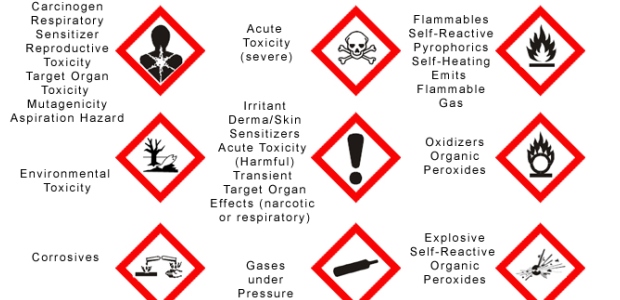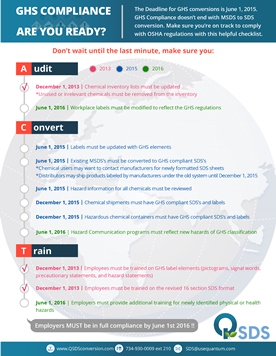
Common MSDS-to-SDS Conversion Questions
According to OSHA, any chemical that could possibly cause any physical or health effect under expected conditions of use or reasonably anticipated conditions of misuse is hazardous.
- By Amanda Yerke
- May 01, 2015
 As a sales associate, I spend a lot of time discussing GHS regulations with clients. Most of the questions I field are industry specific, and they often pertain to individual products or formulations. However, there are a few themes that dominate my conversations with potential clients: label requirements, international validity, trade secrets, mixture composition, and physical hazards.
As a sales associate, I spend a lot of time discussing GHS regulations with clients. Most of the questions I field are industry specific, and they often pertain to individual products or formulations. However, there are a few themes that dominate my conversations with potential clients: label requirements, international validity, trade secrets, mixture composition, and physical hazards.
Business owners throughout the United States are making an effort to comply with OSHA's June 1, 2015, deadline. However, the specific conversion requirements are confusing and ambiguous. As most of you know, the Globally Harmonized System (GHS) has published various versions of the "purple book," an enormous manuscript filled with complex explanations that are intended to provide clear guidelines for chemical classification. The irony of such a complex system, which was intended to provide clear and uniformed safety standards, is not lost on us here at Quantum.
1. What are the elements of a GHS Safety Data Sheet that need to be represented on a label?
In accordance with GHS regulations, there are six components that must be included on a label for a hazardous chemical:
1. Name
2. Address and telephone number
3. Product identifier
4. Signal word
5. Hazard statement(s)
6. Precautionary statement(s)
y. Pictogram(s)
The intention of a label is to empower employees to easily identify potential workplace hazards. It's imperative the employers evaluate their current labeling system to determine whether or not their labels clearly answer the question, "What are the dangers of this chemical?"
2. If the GHS is a globally harmonized system, are my SDSs valid worldwide?
No. GHS is a voluntary international system that implements a framework for standardizing compliance regulations, such as converting MSDSs to SDSs. Countries have the option to adopt and implement freely, which creates varied transition deadlines. More specifically, only Competent Authorities (CA)--such as EPA, OSHA, and Health Canada--have the authority to decide which GHS building blocks to incorporate, which is dependent on the needs of their target audience and the CA.
GHS building blocks are the key elements that make up the SDS, such as: pictograms, labels, classes, categories, etc. A prime example of applying different GHS building blocks while remaining GHS compliant is comparing the EU CLP (the EU regulation on classification, labelling and packaging of substances and mixtures) to OSHA’s Hazard Communication Standard (HCS). Here are a few differences between the two:
| Aspect |
EU CLP
|
OSHA's GHS
|
| Pictograms |
Empty red-frame diamonds not expressly prohibited
|
Empty red-frame diamonds expressly prohibited
|
| Labels |
Specific minimum size specified
|
No specific minimum size specified
|
Class/ categories
|
Not controlled: Flam liquid category 4, Acute Tox Cat 5, Skin irritation 3, Eye irritation 2B, Aquatic Acute Categories 2 and 3
|
Not controlled: Acute Tox Cat 5, Any aquatic acute and chronic
|
So with the variability among GHS building blocks, will your U.S. SDSs be valid outside the country? Well, although the GHS specifications will vary by country and region, U.S. GHS-compliant SDSs are generally valid globally, with a few exceptions, such as the EU. OSHA's HCS has different specifications than the EU CLP, and thus, although your SDSs may be GHS compliant within the United States, they will not comply with the EU CLP specifications. Therefore, to conduct business with an EU-based company, you would have to re-author or convert your (M)SDSs to the EU CLP.
3. How do I protect the composition of my ingredients on SDSs while still complying with GHS regulations?
In order to accurately answer that question, it's imperative to know where my clients plan to ship their products, because countries have varied approaches to trade secrets.
In the United States, OSHA allows for claims of trade secrets and proprietary ingredients on GHS-compliant SDSs. However, in addition to federal regulations, there are also state-specific requirements that may apply to your products. It's important to note that upon requests from health care providers, manufacturers must be prepared to provide full disclosure.
If you're using a service provider to facilitate your transition, make sure to identify at the beginning of the conversion process which ingredients are proprietary. This will enable you to initiate a conversion that ensures you are protecting product ingredients while simultaneously adhering to OSHA's regulations.
4. When do I have to disclose the components of a mixture on a GHS-compliant SDS?
OSHA requires that all hazardous components in excess of 1 percent be addressed on GHS-compliant SDSs. Additionally, carcinogens in excess of 0.1 percent must be disclosed.
Fortunately, you do not have to disclose the exact percentages of mixture components. Instead, you can provide the composition information as a range of percentages (e.g., 5-10 percent).
According to OSHA, any chemical that could possibly cause any physical or health effect under expected conditions of use or reasonably anticipated conditions of misuse is hazardous.
5. Which GHS physical hazards need to be covered on the SDS?
When it comes to hazard classification, the GHS criteria are designed to be consistent, transparent, and draw a clear distinction between various classes and categories for companies and individuals.
The physical hazards classification process provides specific references to approved test methods and criteria for classification. The GHS physical hazard criteria apply to mixtures under the assumption that said mixtures will be tested for physical hazards. Previously, there were many different systems across the world that had similar qualitative criteria for various physical hazards.
The globally harmonized system defines the following physical states:
- Gas: a substance or mixture that has a vapor pressure greater than 300 kPa at 50° C or is completely gaseous at 20° C and has a standard pressure of 101.3 kPa.
- Liquid: a substance or mixture that is not a gas and has a melting point or initial melting point of 20° C or less at a standard pressure of 101.3 kPa
- Solid: a substance or mixture that does not meet the definitions of a liquid or a gas.
In addition to questions about chemical classifications and label requirements, I also field a great number of inquiries concerning OSHA’s deadlines. Fortunately, these deadlines are much more straightforward than the regulation requirements! We have compiled a GHS checklist (shown in this article) that clearly illustrates past, present, and future deadlines for both manufacturers and distributors. Not all of these deadlines pertain to conversion; some of them address training or labeling. But they're all important to keep in mind as you transition to the Globally Harmonized System.
Unfortunately, I recognize that I've only begun to scratch the surface. If you have additional questions or concerns about GHS compliance or MSDS conversion (which I'm sure some of you have), please feel free to shoot me an email or give me a call. I'm happy to help.
This article originally appeared in the May 2015 issue of Occupational Health & Safety.